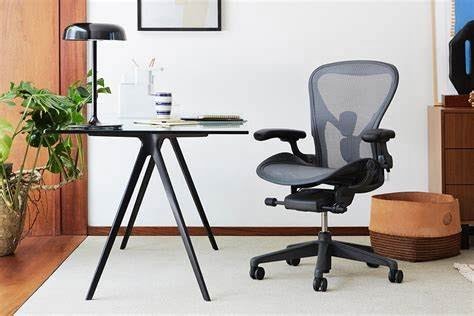Selecting ergonomic office chairs and office furniture is crucial for achieving maximum comfort and productivity in your workspace. Ergonomic design focuses on optimizing the interaction between the user and their environment, reducing strain and promoting a healthier posture. To ensure you choose the right ergonomic office chair and furniture for your needs, consider the following essential tips.
Focus on Adjustable Features
When choosing an ergonomic office chair, the adjustability of its features is paramount. Look for a chair that allows you to customize various settings, including seat height, backrest tilt, and armrest positioning. These adjustments enable you to tailor the chair to your body’s specific needs, ensuring proper alignment and reducing discomfort during long hours of work.
Seat height adjustment is particularly important to ensure that your feet are flat on the floor and your knees are at a 90-degree angle. A reclining backrest and adjustable lumbar support can help alleviate lower back strain by supporting the natural curve of your spine. Armrests should be adjustable to provide support for your arms and shoulders, minimizing tension and promoting a relaxed posture.
Prioritize Lumbar Support
Lumbar support is a critical aspect of ergonomic office chairs. Adequate lumbar support helps maintain the natural curve of your lower back, reducing the risk of back pain and discomfort. Look for a chair with adjustable lumbar support that can be positioned to fit the curve of your spine precisely. Some chairs offer built-in lumbar support that is contoured to provide consistent support, while others allow you to adjust the height and depth of the support to suit your preferences.
Evaluate Seat Cushion Quality
The quality of the seat cushion plays a significant role in overall comfort. An ergonomic chair should have a well-padded, high-density foam cushion that distributes your weight evenly and reduces pressure points. The seat should be deep enough to support your thighs without restricting blood flow. Consider options with a waterfall edge that slopes downward to relieve pressure on the back of your legs and improve circulation.
Consider the Backrest Design
The design of the backrest is essential for supporting your upper body and encouraging good posture. Choose a chair with a backrest that supports the entire back, including the shoulders and upper back. A chair with a high backrest is beneficial for those who prefer extra support for their shoulders and neck. Additionally, look for a chair with a backrest that can be adjusted in both angle and height to accommodate various sitting positions and preferences.
Assess Mobility and Stability
Mobility and stability are important factors to consider when selecting ergonomic office furniture. A chair with a stable five-point base and smooth-rolling casters provides a secure foundation and allows you to move freely around your workspace. Ensure that the casters are suitable for your flooring type, whether it’s carpet, hardwood, or tile. The ability to swivel and move effortlessly can enhance your productivity and comfort by allowing you to reach different areas of your desk without straining.
Evaluate Desk Height and Depth
In addition to the office chair, the height and depth of your desk are crucial for ergonomic comfort. Your desk should be at a height that allows you to maintain a neutral wrist position while typing and using a mouse. Your elbows should be at a 90-degree angle or slightly obtuse when your hands are on the keyboard. The depth of the desk should be sufficient to accommodate your monitor at a comfortable viewing distance while providing space for your arms to rest naturally.
Select Adjustable Office Furniture
Adjustable office furniture is a key component of an ergonomic workspace. Consider investing in an adjustable desk that allows you to switch between sitting and standing positions. Sit-stand desks can help reduce the negative effects of prolonged sitting and promote better posture and circulation. Additionally, look for other adjustable furniture options, such as monitor arms and keyboard trays, to enhance your workspace’s ergonomic setup.
Choose High-Quality Materials
The materials used in office furniture can impact both comfort and durability. Opt for high-quality materials that provide adequate support and resist wear and tear. For office chairs, look for breathable fabrics or mesh that allow for proper ventilation and temperature regulation. Durable materials ensure that your furniture maintains its comfort and functionality over time, reducing the need for frequent replacements.
Consider Aesthetic and Design
While ergonomic functionality is essential, the aesthetic and design of your office furniture should also be considered. Choose office furniture that complements your workspace and reflects your personal style. Ergonomic furniture is available in various designs and finishes, so you can find options that not only provide comfort but also enhance the overall look of your office.
Test Before You Buy
Before finalizing your purchase, take the time to test different ergonomic office chairs and furniture. Visit showrooms or stores where you can try out the chairs and desks to assess their comfort and adjustability. Spend some time sitting in the chair and using the desk to ensure they meet your ergonomic needs and preferences. Testing the furniture in person allows you to make a more informed decision and avoid potential issues with comfort or fit.
Choosing ergonomic office chairs and office furniture is essential for creating a comfortable and productive work environment. By focusing on adjustable features, lumbar support, seat cushion quality, backrest design, mobility, desk height, and the overall design, you can enhance your workspace and improve your well-being. With the right ergonomic furniture, you’ll be well-equipped to tackle your work tasks with maximum comfort and efficiency.
Refresh Date: August 21, 2025










